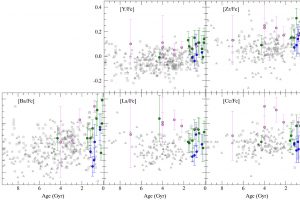The chemical evolution of the Milky Way unveiled by GES. The study “The Gaia-ESO Survey: the origin and evolution of s-process elements” of L. Magrini (INAF – OA Arcetri) published in Astronomy & Astrophysics

The study of the chemical abundances of stars with different age and position in the Milky Way provide crucial information on the formation and evolution of our Galaxy. In particular, heavy elements (i.e. those with the atomic number Z > 30) are produced by the successive capture of neutrons by lighter elements. This occurs by two processes, the slow s-process and the fast r-process. In the former case the timescale for neutron capture is hundreds of thousand years long, while in the latter case only a fraction of a second. The s-process is also divided in three different processes: the “main” process occurring in the AGB (Asymptotic Giant Branch) stars; the “weak” process occurring in massive stars and producing elements with N<89, and the “strong” process occurring low-metallicity AGB stars.
Several astronomers have searched for correlations between the chemical abundances of stars and their age. For instance, D’orazi et al. (2009) have shown that the abundance of Ba increases with the age of the studied clusters. Other studies analyze the abundance of elements produced by the s-process, but the resulting picture is still not well determined.
This is the topic of the study “The Gaia-ESO Survey: the origin and evolution of s-process elements” of L. Magrini (INAF -Astrophysical Observatory of Arcetri), recently appeared on Astronomy & Astrophysics. The authors have analyzed the high resolution spectra provided by the Gaia-ESO Survey, which provides homogeneous measurements of the chemical abundances for a large sample of stellar clusters. In the paper are presented the abundances derived in clusters at various ages both in the thin and thick galactic disk, of several elements produced by the neutron capture: Y, Zr, Ba, La and Ce produced by the s-process, Eu produced by the r-process, and Mo, Pr, and Nd produced by both processes. The study confirms the increase of the abundances of five elements (Y, Zr, Ba, La e Ce) with stellar age. Besides, the observed abundances can be justified if a significant contribution by the low-mass stars is provided, and if elements are produced also by the i-process, occurring in the H and He burning layers in massive stars. The astronomers Rosaria Bonito, Francesco Damiani, and Loredana Prisinzano of the Astronomical Observatory of Palermo are coauthors of this study.
The figure (link) shows the abundances of 5 elements in stars with different age.
of Mario Giuseppe Guarcello ( follow mguarce)
